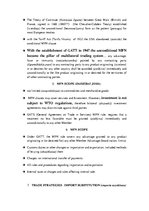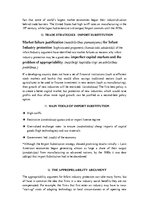-
Most-Favored-Nation
9. TRADE STRATEGIES - IMPORT SUBSTITUTION
The chief argument (galvenais arguments) behind Import Substitution was Infant Industry protection, According to the Infant Industry argument; developing countries have potential comparative advantage. In manufacturing, but new manufacturing industries in developing countries cannot initially (sākotnēji nevar konkurēt) compete with well-established manufacturing in developed countries. To allow manufacturing to get a toehold (atbalstu), then, government should temporarily (uz laiku) support ne industries until they have grown strong enough to meet international competitors. Thus it makes sense, according (lietderīgi saskaņā) to this argument, to use tariffs or import quotas as temporary measures to get industrialization started. It is a historical fact that some of world’s largest market economies began their industrialization behind trade barriers: The United States had high tariff rates on manufacturing in the 19th century, while Japan had extensive (vērienīgas) Import controls until the 1970s.
10. TRADE STRATEGIES - IMPORT SUBSTITUTION
Market failure justification (neatbilstības pamatojums) for Infant Industry protection: Sophisticated proponents (Izsmalcināti atbalstītāji) of the infant Industry argument have identified two market failures as reasons why infant industry protection may be a good idea: imperfect capital markets and the problem of appropriability. (nepilnīgi kapitāla tirgi un atbilstības problēma.)
…





